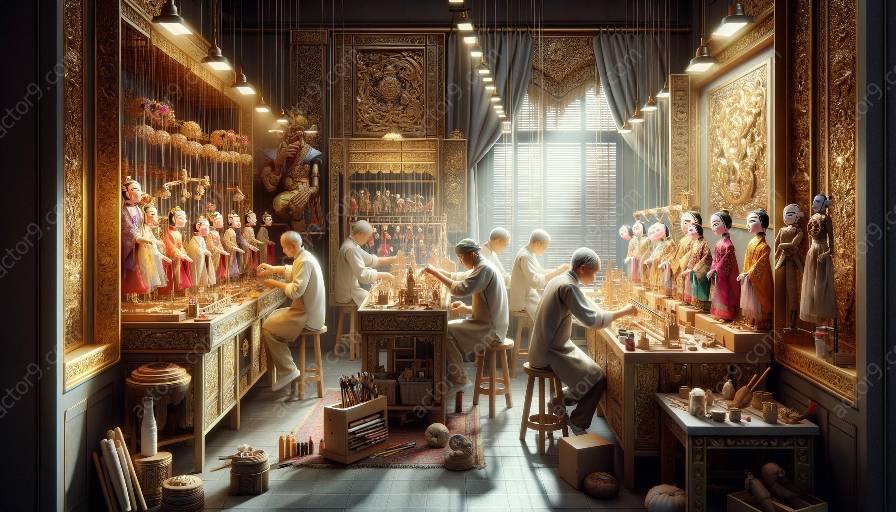Puppets have been an integral part of theater for centuries, capturing audiences' imaginations and bringing stories to life through the art of puppetry. In contemporary theater, the construction techniques used to create puppets play a crucial role in enhancing storytelling, enabling a deeper connection with the audience through the manipulation and performance of these unique and expressive characters.
The Role of Puppet Construction Techniques
Puppet construction techniques encompass a range of design and fabrication methods, each contributing to the creation of compelling and effective puppets for the stage. These techniques encompass the use of various materials, such as wood, fabric, foam, and other sculpting materials, as well as the integration of mechanical and electronic components to bring puppets to life in a dynamic and engaging manner.
One of the primary ways in which puppet construction techniques enhance storytelling is through the creation of puppets that are visually captivating and evocative. A well-crafted puppet can convey emotion, personality, and character traits through its design and construction, enabling the audience to form a connection with the puppet as a distinct and memorable presence in the narrative.
Design and Fabrication
The design and fabrication phase of puppet construction involves careful consideration of the puppet's appearance, functionality, and durability. Puppet designers and fabricators work collaboratively to bring the vision of the puppet to life, utilizing a combination of artistic expression and technical skill to ensure that the puppet's construction aligns with the overarching storytelling goals of the theatrical production.
During this phase, attention is paid to the materials and construction methods used, ensuring that the puppet is not only visually appealing but also capable of withstanding the demands of live performance. From the initial sketches and mockups to the final construction and finishing touches, the design and fabrication process is a crucial component in creating puppets that effectively convey the intended narrative elements to the audience.
Manipulation and Performance
Once the puppets are constructed, the techniques of manipulation and performance come into play, shaping how the puppets interact with the environment, other characters, and the audience. Puppeteers are trained in the art of bringing puppets to life, using their movements, gestures, and vocalizations to imbue the puppet with personality and expression, further enhancing the storytelling experience.
Through the use of intricate puppet construction techniques, puppeteers can seamlessly integrate the movements of the puppets with the actions of live actors, creating a cohesive and immersive theatrical world that captivates and inspires audiences. The fusion of puppetry with traditional acting techniques allows for a rich tapestry of storytelling possibilities, expanding the creative potential of theater productions and enriching the audience's experience.
The Importance of Puppetry in Crafting Engaging Narratives
Embracing puppet construction techniques in theater not only enhances the visual and performative aspects of storytelling but also contributes to the overall depth and impact of the narratives presented on stage. Puppets have a unique ability to convey emotions and convey complex themes in a visually compelling and accessible manner, transcending language and cultural barriers to resonate with diverse audiences.
Furthermore, puppetry opens doors to innovative storytelling approaches, allowing for the exploration of fantastical worlds, mythical creatures, and larger-than-life characters that may be challenging to portray through traditional acting alone. By integrating puppet construction techniques into theatrical productions, storytellers can unleash their creativity, pushing the boundaries of narrative expression and inviting audiences on a transformative journey that blurs the lines between reality and imagination.
Captivating Audiences and Inspiring Imagination
Ultimately, the fusion of puppet construction techniques with storytelling in theater serves to captivate audiences and inspire their imagination, creating lasting memories and emotional connections that endure long after the final curtain falls. By harnessing the power of puppetry to amplify the impact of narratives, theater-makers can engage with audiences on a profound level, fostering a sense of wonder, empathy, and shared storytelling experiences that unite communities and transcend generations.
As the art of puppetry continues to evolve and innovate, embracing new technologies and artistic approaches, the potential for puppet construction techniques to enhance storytelling in theater remains a boundless frontier, offering limitless possibilities for crafting unforgettable theatrical moments and leaving a lasting impression on the hearts and minds of all who partake in the magic of puppetry on stage.


























